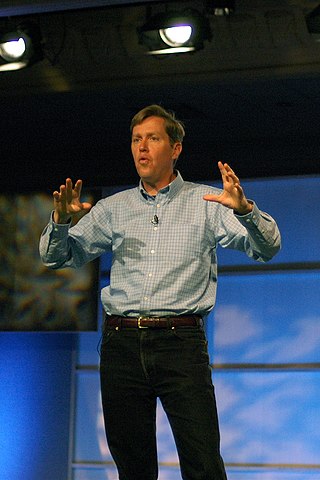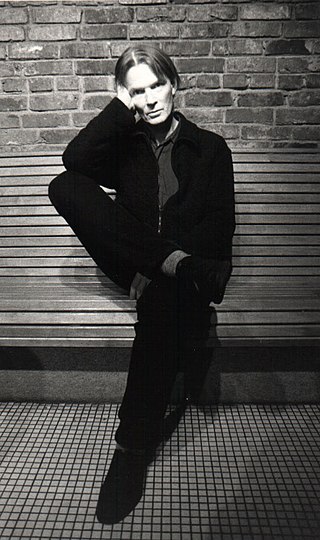
A factoid is either an invented or assumed statement presented as a fact, or a true but brief or trivial item of news or information.
A retronym is a newer name for an existing thing that helps differentiate the original form from a more recent one. It is thus a word or phrase created to avoid confusion between older and newer types, whereas previously no clarification was required.

Wired is a monthly American magazine, published in print and online editions, that focuses on how emerging technologies affect culture, the economy, and politics. Owned by Condé Nast, it is headquartered in San Francisco, California, and has been in publication since March/April 1993. Several spin-offs have been launched, including Wired UK, Wired Italia, Wired Japan, and Wired Germany.

Nicholas Negroponte is a Greek American architect. He is the founder and chairman Emeritus of Massachusetts Institute of Technology's Media Lab, and also founded the One Laptop per Child Association (OLPC). Negroponte is the author of the 1995 bestseller Being Digital translated into more than forty languages.
John Walker is a computer programmer, author and co-founder of the computer-aided design software company Autodesk. He has more recently been recognized for his writing on his website Fourmilab.

William Lewis Safire was an American author, columnist, journalist, and presidential speechwriter. He was a long-time syndicated political columnist for The New York Times and wrote the "On Language" column in The New York Times Magazine about popular etymology, new or unusual usages, and other language-related topics.

Jeffrey Hawkins is an American businessman, neuroscientist and engineer. He co-founded Palm Computing — where he co-created the PalmPilot and Treo — and Handspring.

James Dennis Carroll was an American author, poet, autobiographer, and punk musician. Carroll was best known for his 1978 autobiographical work The Basketball Diaries, which inspired a 1995 film of the same title that starred Leonardo DiCaprio as Carroll, and his 1980 song "People Who Died" with the Jim Carroll Band.
The information superhighway is a late-20th-century phrase that aspirationally referred to the increasingly mainstream availability of digital communication systems.

John Gregory Markoff is a journalist best known for his work covering technology at The New York Times for 28 years until his retirement in 2016, and a book and series of articles about the 1990s pursuit and capture of hacker Kevin Mitnick.

Timothy William Bray is a Canadian software developer, environmentalist, political activist and one of the co-authors of the original XML specification. He worked for Amazon Web Services from December 2014 until May 2020 when he quit due to concerns over the terminating of whistleblowers. Previously he has been employed by Google, Sun Microsystems and Digital Equipment Corporation (DEC). Bray has also founded or co-founded several start-ups such as Antarctica Systems.

George Franklin Gilder is an American investor, author, economist, and co-founder of the Discovery Institute. His 1981 book, Wealth and Poverty, advanced a case for supply-side economics and capitalism during the early months of the Reagan administration. He is the chairman of George Gilder Fund Management, LLC.

Blobitecture, blobism and blobismus are terms for a movement in architecture in which buildings have an organic, amoeba-shaped, building form. Though the term blob architecture was in vogue already in the mid-1990s, the word blobitecture first appeared in print in 2002, in William Safire's "On Language" column in the New York Times Magazine in an article entitled "Defenestration". Though intended in the article to have a derogatory meaning, the word stuck and is often used to describe buildings with curved and rounded shapes.

Richard "Dick" Francis Lyon is an American inventor, scientist, and engineer. He is one of the two people who independently invented the first optical mouse devices in 1980. He has worked in signal processing and was a co-founder of Foveon, Inc., a digital camera and image sensor company.
Netocracy was a term invented by the editorial board of the American technology magazine Wired in the early 1990s. A portmanteau of Internet and aristocracy, netocracy refers to a perceived global upper-class that bases its power on a technological advantage and networking skills, in comparison to what is portrayed as a bourgeoisie of a gradually diminishing importance.
"Wingnut", wing nut or wing-nut, is a pejorative American political term referring to a person who holds extreme, and often irrational, political views.

Benjamin Zimmer is an American linguist, lexicographer, and language commentator. He is a language columnist for The Wall Street Journal and contributing editor for The Atlantic. He was formerly a language columnist for The Boston Globe and The New York Times Magazine, and editor of American dictionaries at Oxford University Press. Zimmer was also an executive editor of Vocabulary.com and VisualThesaurus.com.
The Jargon File is a glossary and usage dictionary of slang used by computer programmers. The original Jargon File was a collection of terms from technical cultures such as the MIT AI Lab, the Stanford AI Lab (SAIL) and others of the old ARPANET AI/LISP/PDP-10 communities, including Bolt, Beranek and Newman, Carnegie Mellon University, and Worcester Polytechnic Institute. It was published in paperback form in 1983 as The Hacker's Dictionary, revised in 1991 as The New Hacker's Dictionary.
Sol Steinmetz was a Hungarian American linguistics and lexicography expert who wrote extensively about etymologies, definitions and uncovered earliest recorded usages of words in English and Yiddish. A widely sought source on all things lexical, he earned recognition from William Safire in his On Language column in The New York Times Magazine in 2006 as a "lexical supermaven".

The word bespoke has evolved from a verb meaning 'to speak for something', to its contemporary usage as an adjective. Originally, the adjective bespoke described tailor-made suits and shoes. Later, it described anything commissioned to a particular specification. In contemporary usage, bespoke has become a general marketing and branding concept implying exclusivity and limited runs.












